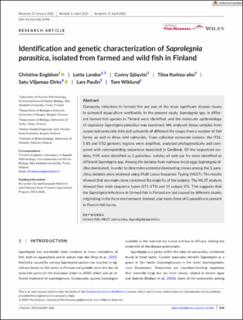Identification and genetic characterization of Saprolegnia parasitica, isolated from farmed and wild fish in Finland
Engblom, Christine; Landor, Lotta Anni Ingeborg; Sjöqvist, Conny; Korkea-aho, Tiina; Viljamaa-Dirks, Satu; Paulin, Lars; Wiklund, Tom
Journal article, Peer reviewed
Published version

Åpne
Permanent lenke
https://hdl.handle.net/11250/3083261Utgivelsesdato
2023Metadata
Vis full innførselSamlinger
- Department of Biological Sciences [2232]
- Registrations from Cristin [9766]
Sammendrag
Oomycete infections in farmed fish are one of the most significant disease issues in salmonid aquaculture worldwide. In the present study, Saprolegnia spp. in different farmed fish species in Finland were identified, and the molecular epidemiology of especially Saprolegnia parasitica was examined. We analysed tissue samples from suspected oomycete-infected salmonids of different life stages from a number of fish farms, as well as three wild salmonids. From collected oomycete isolates, the ITS1, 5.8S and ITS2 genomic regions were amplified, analysed phylogenetically and compared with corresponding sequences deposited in GenBank. Of the sequenced isolates, 91% were identified as S. parasitica. Isolates of yolk sac fry were identified as different Saprolegnia spp. Among the isolates from rainbow trout eggs Saprolegnia diclina dominated. In order to determine potential dominating clones among the S. parasitica, isolates were analysed using Multi Locus Sequence Typing (MLST). The results showed that one main clone contained the majority of the isolates. The MLST analysis showed four main sequence types (ST1–ST4) and 13 unique STs. This suggests that the Saprolegnia infections in farmed fish in Finland are not caused by different strains originating in the farm environment. Instead, one main clone of S. parasitica is present in Finnish fish farms.
